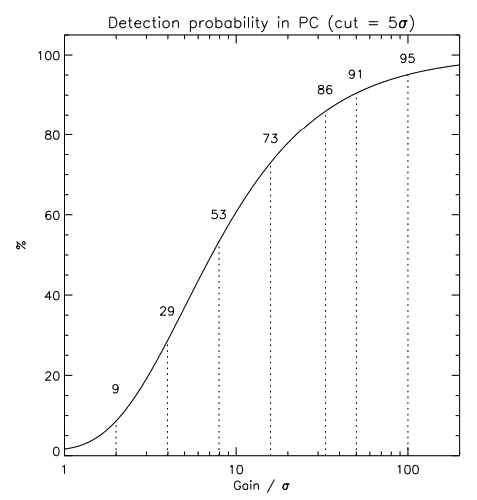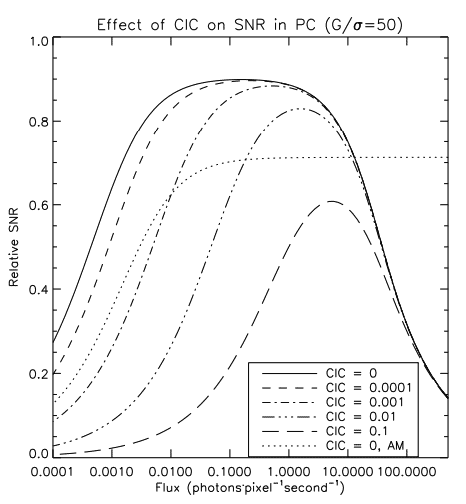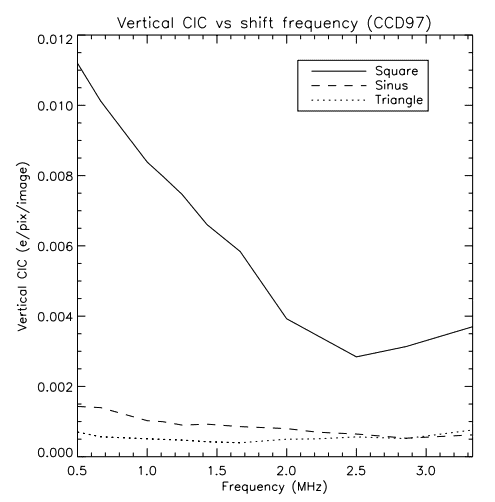Menu
close
Produits
Votre solution complète
Tous les produits
Télécharger notre catalogue
Obtenir notre catalogue
Applications
Photon Counting (PC) efficiency has increased since the first photon counting devices. Third generation image intensifiers with high Quantum Efficiency (QE) photocathodes (of the order of 30%) are used with CCDs in intensified photon counting systems. But, the efficiency of this kind of camera is limited by the capability of the tube to transform an incoming photon into an electron and amplifying it so that the output signal is largely over the CCD Read-out Noise (RON). Improvements in CCD QE, which now reaches 90% at some wavelengths, and RON, as low as 3e, have no effect on the total counting efficiency of these cameras. RON of 3e is still too high for an application such as photon counting for extreme faint fluxes. It is now possible to amplify the pixel signal into the CCD before it reaches the output amplifier and before it is affected by its noise. These Electron Multiplying CCD make it is possible to get sub-electron effective RON, low enough for PC. PC capability combined with a very low dark current, very good pixel response uniformity, and high QE offered by the CCD technology have made EMCCD the detector of choice for high-performance applications such as time resolved spectroscopy and low light imaging.
Charge Coupled Devices (CCDs) are extremely sensitive devices for imaging in the visible, capable of detecting nearly all the photons that reach them, at certain wavelengths. They exhibit a very good pixel response uniformity, excellent flatness, low read-out noise and, when cooled, very low dark current. However, when light become sparse, their read-out noise renders impossible the detection of single photons accumulated into its pixels. The Signal-to-Noise Ratio (SNR) of a CCD can be calculated by the following formula:
where QE is the Quantum Efficiency (QE) of the pixel, S is the incoming flux, T is the dark current, C is the Clock Induced Charges (CIC), and σ is the Read-out Noise (RON). For faint-flux imaging applications, where S is small, overcoming the readout noise is essential. In order to translate their high sensitivity into high signal-to-noise ratio images, the CCDs must be exposed for an extended period of time before being read-out. Under some circumstances when the exposure time is limited, this renders the CCD unsuited.
The advent of the Electron Multiplying CCD (EMCCD) made it possible to break readout noise barrier, by applying a gain in the charge domain, before the signal reaches the noisy output amplifier. This way, the RON is effectively reduced by the magnitude of the gain, rendering single photon detection possible on a CCD focal plane [1]. Whilst its Electron Multiplying (EM) register amplifies electrons before they reach the noisy charge-to-voltage amplifier, the multiplication process has a stochastic behaviour which results in an Excess Noise Factor (ENF). Taking the ENF into account, one can modify the SNR formula to account for the characteristics of the EMCCD in the following way:
where F is the ENF, and G is the gain applied to the pixel’s signal. Since in the case of the EMCCD F is √ 2 at high gains [2], it has the same effect as if the QE of the device would be halved. The ENF affects the observations processed in the so-called Analogue Mode (AM), where the amount of photons contained in a pixel is obtained by dividing the pixel’s value by the EM gain. One can get rid of the ENF by considering the EMCCD’s pixel as being binary. This single threshold processing strategy, hereafter referenced as the Photon Counting (PC) strategy, will be discussed below.
The PC strategy simply considers the pixel as being empty if its output value is less than the threshold or as having accumulated one single photo-electron if its value is higher than the threshold. This processing have an obvious impact on the dynamic range of the EMCCD which can be compensated by taking multiple short exposures and summing them. In this regime, however, CIC, electrons that are generated as the device is read-out, is the dominant source of noise [3]. In order to lower its impact on the SNR, the level of CIC of an EMCCD operated in PC must be kept low [4]. Operating the EMCCD in Non-Inverted Mode Operation (NIMO) effectively reduces the level of the CIC, at the price of an increased dark current.
In PC, it is the ratio of the EM gain over the real read-out noise (hereafter G/σ) that sets the detection probability of a photo-electron (Fig. 1). For a given σ, a higher gain will have a higher probability of amplifying the photo-electron enough to take it above the threshold (typically set at 5 σ). Unfortunately, the EM gain can’t be made arbitrarily high as the CIC scales with the EM gain [5].

The SNR formula of an EMCCD operated in PC can be rewritten in the following way:
where DP is the detection probability. The reader should note that σ is not present anymore since the threshold has suppressed the Gaussian noise. Moreover, G is not present either has it is implied in the DP term.
Thus, the operation of an EMCCD in PC mode is challenging in many ways:
• The EMCCD must be operated at a high frame rate;
• The CIC dominates over all the other sources of noise at high frame rate;
• The G/σ ratio must be high to allow the detection of a high proportion of photo-electrons;
• The CIC scales with the EM gain;
• The CIC is stronger in inverted mode, where holes populate the surface during the integration period;
• It is preferable to try to operate the EMCCD in inverted mode to lower the impact of the dark signal: it would be useless to reduce the CIC at the price of a higher dark signal.
The last two points arise in part from the fact that Charge Transfer Efficiency (CTE) in the EM stage of the EMCCD suffers from low temperatures [5]. In order to counterbalance this low CTE, higher clock amplitude must be used, resulting in an increased CIC (CIC is mostly independent of the operating temperature, for a given clock amplitude). It was found that an operating temperature of -85◦C to -90◦C was a good compromise.
An easy conclusion one may draw from these facts is that the CIC must be taken to very low levels even when using high a EM gain for the PC operation to be efficient (which is also expressed by Fig. 2), and preferably whilst keeping the EMCCD in Inverted Mode Operation (IMO) (also called Multi Pinned Phase, or MPP) to keep the dark current to low levels. This capability is at the core of Nuv¨ u¨ Cameras’ technology. This technology consists of an electronic controller dedicated to generating a low level of CIC when reading-out an EMCCD. This electronic controller achieves its task by generating clocking signals with a controlled shape. As opposed to conventional controllers whose clocks are essentially square and binary (the clocks just toggles between two preset voltages), Nüvü Camēras' controller can shape the transition between clock cycles to lower the generation of the unwanted CIC. As shown in Figure 3, using alternative clock shapes for the vertical clocking does almost suppress the generation of the CIC (well below 0.001 e/pix/image), even when the EMCCD is operated in IMO.


With the EMCCD, once the CIC is diminished to negligible levels, the detector is truly capable of providing shot noise limited performance even for fluxes well below 1 photon/pix/image.
Nüvü Camēras has developed thermoelectrically cooled cameras to support the three commercially available scientific EMCCD devices: the CCD60 (128×128), the CCD97 (512×512), and the CCD201-20 (1024×1024)1 . In order to get a low dark current, the detectors are always clocked in IMO and the cameras allows cooling to -85◦C. All of the cameras allows the detectors to be clocked at up to 20 MHz of pixel rate, which yield up to 1000, 63, and 17 full frames per second on the 128, 512, and 1024 devices, respectively. Moreover, to increase the detection probability, DP , in PC, the cameras are calibrated to yield EM gains of up to 5000.
In order to better benefit of the PC operation, read-out features such as multiple Regions of Interest (ROIs), and cropped-sensor mode are implemented. As an example, the multiple ROI allows the 512 camera to generate 800 frames per second for three regions of 8 pixel high each [6]. This unique functionality is mandatory for demanding applications where low light levels meet high speed requirements such as for adaptive optics
The cameras also demonstrated their capability at imaging extreme faint flux, such as the ones expected for exoplanet imagery. In those cases, the expected fluxes are of the order of 1 photon/pix/hour, and it was shown that such a low signal was observable even with the use of several short (10–90 s) individual integrations [7]. In fact, there is little impact on the SNR from using very short (10 s) as compared to moderately long (300 s) exposures, even if a photon would be detected only once per 100’s of frames in the shortest exposures case. Those short integrations are valuable in the scope of space applications since they relax the requirement on the pointing accuracy of the spacecraft and mitigate the impact of the energetic cosmic rays that would pollute the weak signal over long integrations.
Although the multiplication process of EMCCDs is inducing an ENF, and the CIC generated during the read-out process is the dominant source of background signal, it is possible with the proper driving electronics to circumvent those effects and achieve shot noise limited imaging even for fluxes well below 1 photon/pix/image. This unique capability brought by Nüvü Camēras’ products is an enabler for flux starved applications as broad as, to name a few, exoplanet imaging, adaptive optics, speckle imaging, space situational awareness, confocal microscopy, and light field microscopy. Nüvü Camēras also provides consulting and custom development services to its customers to better optimize the use of EMCCDs and low light imaging devices for their applications.
Care must be taken when first dealing with EMCCDs, since the noise behaviour of those devices is counterintuitive. CCD users are used to operate their devices at low speed to get a low noise, because the CCDs are dominated by the readout noise. Since the EMCCD allows sub-electron noise to be achieved, they are dominated by other sources of noise. Those sources of noise do not follow the same trend as the read-out noise (Fig. 3), and, up to a certain extent, a faster operation will yield to a lower noise level.
Notes
1https://www.nuvucameras.com/products
ACKNOWLEDGMENT
Nüvü Camēras wishes to thank the WIO organization for the invitation to participate at the 2018 event.
[1] P. Jerram, P. J. Pool, R. Bell, et al., “The LLCCD: low-light imaging without the need for an intensifier,” in Sensors and Camera Systems for Scientific, Industrial, and Digital Photography Applications II, M. M. Blouke, J. Canosa, and N. Sampat, Eds., Proc. SPIE 4306, 178–186 (2001).
[2] M. Stanford and B. Hadwen, “The noise performance of electron multiplying charge coupled devices,” IEEE Transactions on Electron Devices 1488R (2002).
[3] “Low-light Technical Note 4 Dark Signal and Clock-Induced Charge in L3Vision CCD Sensors,” tech. rep., E2V Technologies, http://www.e2v. com/content/uploads/2015/04/a1a-low-light tn4 3 v1.pdf (2004).
[4] O. Daigle, C. Carignan, J. Gach, et al., “Extreme Faint Flux Imaging with an EMCCD,” Publications of the Astronomical Society of the Pacific 121, 866–884 (2009).
[5] O. Daigle, J.-L. Gach, C. Guillaume, et al., “CCCP: a CCD controller for counting photons,” in Society of Photo-Optical Instrumentation Engineers (SPIE) Conference Series, Society of Photo-Optical Instrumentation Engineers (SPIE) Conference Series 7014 (2008).
[6] F. Rigaut, I. Price, C. d’Orgeville, et al., “NGS2: a focal plane array upgrade for the GeMS multiple tip-tilt wavefront sensor,” (2016).
[7] O. Daigle, O. Djazovski, J. Dupuis, et al., “Astronomical imaging with EMCCDs using long exposures,” in Society of Photo-Optical Instrumentation Engineers (SPIE) Conference Series, Society of Photo-Optical Instrumentation Engineers (SPIE) Conference Series 9154, 0 (2014).